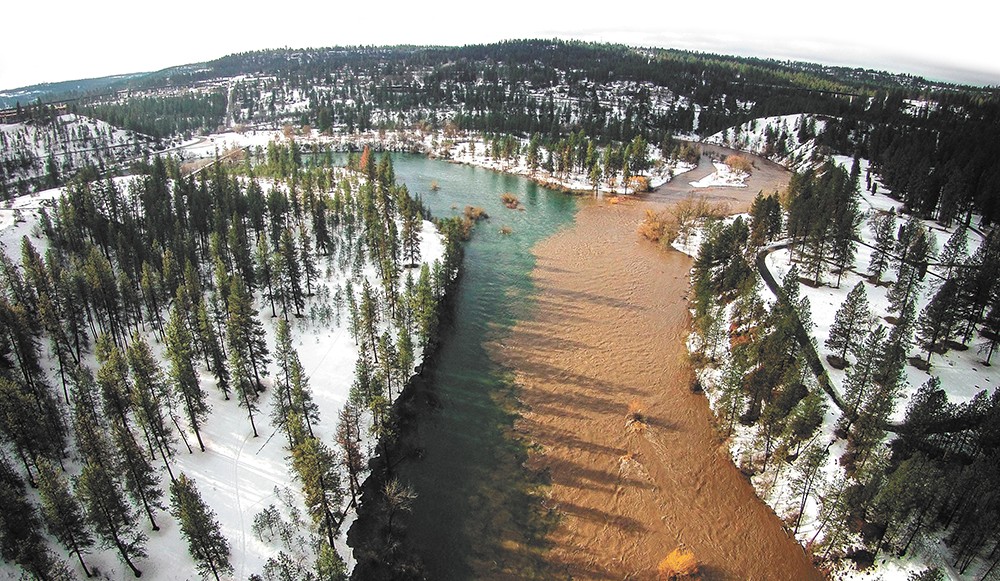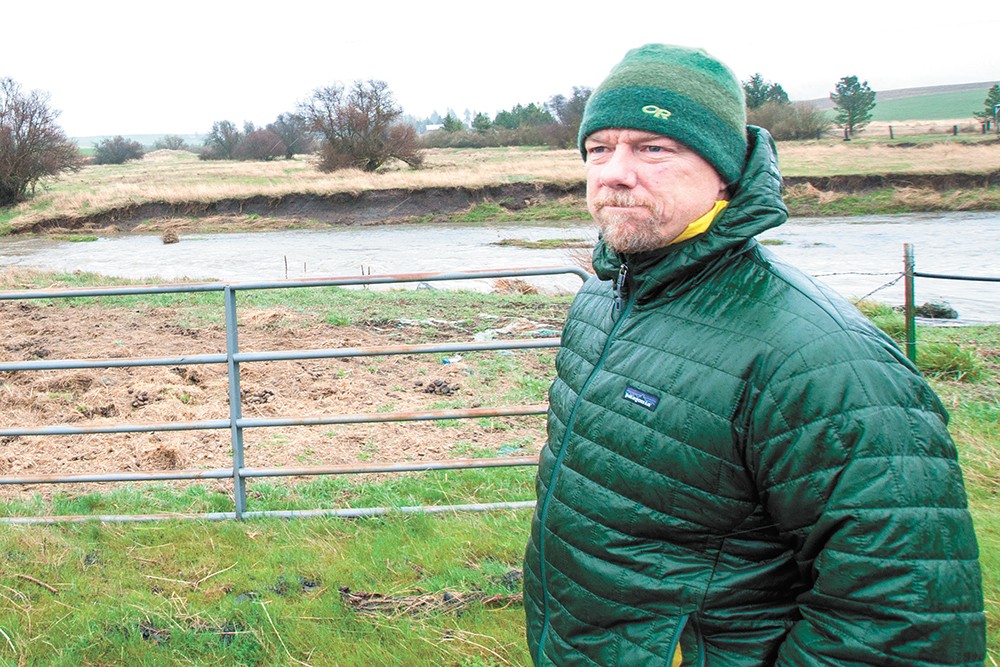
It's one of those days where the rain mixes with snow and the wind sends it sideways. The downpour makes the mud bubble like a black bean soup.
But as Jerry White, the Spokane Riverkeeper, steps out of his truck, boots squishing in the muddy soil near the banks of Hangman Creek, it's perfect.
"You couldn't have asked for a better day," White says. He smiles. "When you get into this business, it's a little morbid. We're always, like, 'Oh man, look at that pollution!'"
Really look at it, he says. Look at the way that the rain turns Hangman and the north fork of Spangle Creek gray and chocolatey brown. The creek has been sick for a long time. Think of it like a patient suffering from fever, a bacterial infection, and losing chunks of their hair.
Hangman Creek, also known as Latah Creek, is choked with bacteria and record levels of dirt. The temperature's too high. There isn't enough vegetation. The water is running too fast, eroding away the banks, sending even more soil sloshing into the river.
But there's good news, White says. For years, the Spokane Riverkeeper had been locked into a legal battle with the Environmental Protection Agency and the Washington State Department of Ecology over the fate of Hangman Creek.
Way back in 2009, Ecology had come up with a clean-up plan detailing all the ecological standards that Hangman Creek had to hit. The problem wasn't the standards, White says. It was that they were toothless — with little guidance on how Ecology was going to enforce its plan.

So in 2015, they sued the EPA for approving Ecology's plan. Last month, the lawsuit was finally settled. Going forward, Ecology will be required to undertake a massive methodical analysis of Hangman Creek, and landowners are tasked to fix the biggest problems.
"The public very often doesn't realize we're entitled to clean water under the law," White says. "That's our birthright as Americans."
The problem with pollution in Hangman Creek isn't necessarily as simple as, say, a malevolent factory pumping waste into the stream. Instead, it's largely the result of a thousand decisions by individual property owners.
"Our culture seems to feel like a river ends right where the water ends," White says. It isn't just the farms. It's the golf courses and the housing complexes — anything that is built right up to the river's edge.
"For 120 years, landowners, farmers and developers have all been taught and known, you clear creeks out, and you clean them up," White says. You imposed order on the chaos of nature. You took messy banks and made them straight and clean.
It was exactly the wrong thing to do. By ripping out the natural plants and trees on a river's edge, you take away the source of shade that keeps the river cool. You tear away the roots that stop the dirt on the banks from being swept into the creek.
"We found documents clear back into the '70s where they talked about the terrible soil erosion happening here," White says.
He cringes at the long bald swatches of soil, laid bare by traditional tilling practices. He watches rainfall slough the dirt into the water.
Traditionally, this stretch of land flooded in the spring and then slowly drained. But farming practices changed that: He points out the big black pipes serpentining through some Hangman Creek properties like giant earthworms. Their job is to drain the soil as fast as possible in the spring. Trenches and ditches do the same thing.
As a result, in the summer months, the river is low and slow — sending temperatures skyrocketing. But in the spring? It's a torrent. Think of what a garden hose does when you stick your thumb in front of it. It cuts like a water jet, slicing away at the shore — especially areas without vegetation. White drives past a creek bank that has been carved into sheer cliffs.
"This is like a wrecking ball when it gets down here," White says. "There's so much water in the river here at this point, that every corner is being torn out. Unbelievable."
White pulls up to the shoulder of the road, peering through the sleet at the two Black Angus cattle grazing at the riverbank.
That's illegal. Cattle can trample soil, gobble up vegetation and poop directly into the river. Cow and horse poop can make for a toxic stew — the fecal nutrients fertilizes algae growth, sucking up the oxygen and suffocating the fish.
At another property, the violation is even worse.
"Oh my god. This guy? See these hay bales? This guy is feeding hay bales right on top of the creek," White says. "You can actually see the horse shit right there."
He yanks the emergency brake, steps out to take a picture. He considers reporting it to Ecology — though he's sure Ecology already knows about it.
As part of the settlement, Ecology will comb the creek and its tributaries, mapping, color coding, geotagging and photographing key locations. They'll conduct public surveys about the watershed's reputation. They'll create PSAs and materials to educate the public.
Ecology spokeswoman Brook Beeler says Ecology has already largely been doing most of the requirements outlined in the settlement agreement. But the settlement codifies it.
"The fact that we've made Hangman a priority watershed means we'll spend more time active in the area," says Beeler. "We'll be on the ground, doing evaluations. We'll have our scientific folks monitoring and assessing and collecting data."
Crucially, they'll be contacting the biggest offending landowners who till their soil in the wrong way or allow livestock to graze in the wrong spots. That won't necessarily be an immediate crackdown initially. At first, Ecology will try to educate and assist the property owners, giving them resources to fix what they're doing wrong.
Beeler says that simply requiring a larger buffer between the creek bank and agricultural or commercial activity will, along with restoring shoreline vegetation, do a lot to restore the creek.
Already, White sees improvement. New trees have been planted. He's encouraged to see some farmers in the Hangman areas using a technique called "direct seed" or "conservation tillage," methods that maintain a short layer of crop stubble instead of tilling it under.
"If you notice, on the ground, that water is not running off," White says. "It mimics the more natural grassland system."
To White, it's proof that farmers and environmentalists can be allies just as easily as enemies. Farmers, too, have an incentive to preserve soil, prevent erosion and keep the river healthy.
"What's good for soil," he says, "is good for water." ♦

